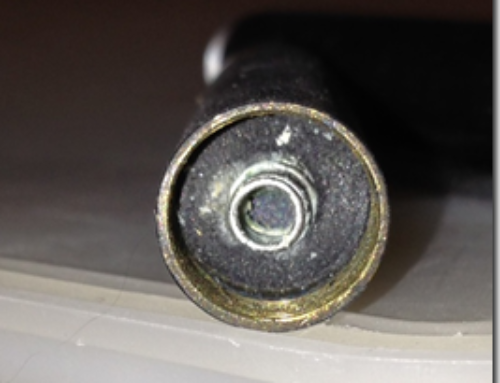The Teledyne LeCroy WaveAce 2034 is a “gateway drug” into digital scopes. It has the front panel interface typical of traditional analog scopes, but with lots more buttons and features which enable us to tap into its powerful digital signal analysis features.
As with a traditional scope, the WaveAce has the features you expect from a general purpose scope: input impedance of 1 Meg or 50 Ohms, 300 MHz input bandwidth or ~ 1.2 nsec instrument intrinsic rise time, 4 channels and typical triggering options.
Then there are the digitizer specs:
- 2 Gsamples/sec, real time sampling with 50 Gsamples/sec in equivalent time sampling (ETS)
- 8 bit vertical resolution
- 12k samples full buffer (the 1000 series has 1 Meg of buffer depth)
As with all digital scopes, it’s a good habit to always adjust the vertical scale to get the signal as large a fraction of the full screen as possible. This maximizes the dynamic range of the ADC and gives the best signal voltage resolution.
One minor difference from what is usually found in other scopes, the front screen has 8 divisions vertically and 18 divisions in the time base. Both the vertical scale per div and the horizontal scale per div are displayed on the front screen, along with a lot of other useful information.
Sampling rate and time base
There are 12k samples in the memory buffer. The time base selected automatically adjusts the sampling rate. The user does not have control of this feature. Given the time per division and 18 div full scale, this defines how much time is actually displayed on the screen. The sampling rate of the ADC is automatically adjusted so that 12k data points takes about 1.2 – 1.5x longer than the displayed data. This maximizes the time resolution per point.
For example, when the time base is 50 usec/div, there are about 18 div x 50 usec = 0.9 msec of data displayed. The sample rate is automatically set to 10 Msamples/sec, so that 12 k points will record a total time interval of 12 k/10 M = 1.2 msec, longer than the displayed time.
The small wavy line at the top of the screen shows how much of the recorded data buffer is actually displayed on the screen.
The wonders of digital scopes
Then there are the cool new features unlocked with digital acquisition. The scope is basically a very fast digitizer, with a built in display and lots of ways of manipulating the measured voltages as a function time time and analyzing the measured data.
Here are just a few of the really cool, new things you can do with a digital scope. Many other features are written up as separate articles elsewhere on my site.
Pre-trigger display of the data.
The data is always being continuously recorded and shoved into a buffer. The trigger condition decides when the buffer gets displayed or stored. This means you can see what was going on before the trigger condition was met.
In this example, a small crystal microphone was the input to channel 2. It was bounced very lightly on the table top. The scope was triggered on a 20 mV threshold. You can clearly see transient response, which was triggered in the middle of the screen.
Exporting CSV data files
The digitized data and the voltage vs time for any or all channels can be exported into a CSV file. Once it’s in a CSV format, it can be read by any suitable program, like excel and then plotted or further processed.
For example, the calibration signal was recorded, exported and plotted in Excel. The resulting plot is shown above.
Parameter calculations
There are more than 20 different calculations that can be performed in real time on the measured data to extract a useful figure of merit, either as a voltage or time figure of merit. this could be the average voltage, the rms value, or even peak to peak.
As a freebie, the scope will almost always display the frequency of any repetitive signal on the screen and can record the 10-90% rise time of a signal. In the example above, my DS334 function generator was set for a 10 kHz square wave and recorded by the scope. The frequency was measured as 9.998 kHz. The rise time is measured and displayed as 16 nsec. This is consistent with the 10 nsec/div time base.
There are a number of other cool digital functions available, such as FFT analysis, but these will be reviewed in other columns.









